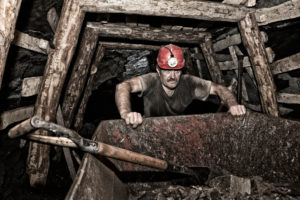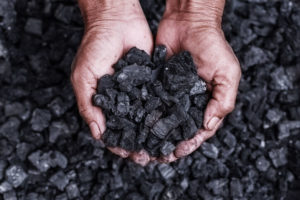Coal Miners & Asbestos-Related Diseases
Coal mining is one of the most dangerous jobs, according to the U.S. Bureau of Labor Statistics. Nearly every day, they face the risk of serious injury from cave-ins or other accidents.
 Besides job-related accidents, miners are at high risk of asbestos exposure since the mineral naturally occurs in coal mines.
Besides job-related accidents, miners are at high risk of asbestos exposure since the mineral naturally occurs in coal mines.
Once inhaled or ingested, microscopic asbestos fibers can settle in the body. The fibers, too microscopic to be removed, cause inflammation and damage that eventually lead to deadly diseases.
Many coal miners may not even be aware they are at risk of developing serious asbestos-related diseases, including mesothelioma and lung cancer. In fact, since symptoms may not develop until 20-50 years after initial exposure, asbestos-related diseases are often not detected until they are in advanced stages.
Coal mining was dangerous work years ago, and it remains so today. Those who spent decades in the mining industry and even modern-day coal miners may still be at risk.
If you have been diagnosed with an asbestos-related disease, contact Sokolove Law today. For over 45 years, our attorneys have helped affected families get the compensation they need.
Billions Recovered Nationwide
We’ve recovered over $5.1 Billion for thousands of asbestos exposure victims and their families nationwide. Let us get you the results you deserve.
How Coal Miners Are Put at Risk of Asbestos Exposure
Asbestos mining no longer occurs in the United States, so coal miners today may not think they are at risk. However, this is not the case.
According to the U.S. Mine Safety and Health Administration, 15% of coal mines contain asbestos. Because of how long it takes to asbestos-related diseases to appear, those who were exposed decades ago could still be at risk of developing a disease in the near future.
Being inside of long, narrow tunnels where asbestos dust has been stirred up through the mining process could expose miners to the dangerous fibers. Being exposed multiple times or for long periods of time increases their risk of getting sick later on.
According to the U.S. Mine Safety and Health Administration, asbestos levels in coal mines were 20 times higher than what is now considered to be “safe.”
If the mining company fails to warn employees or provide necessary protective gear, miners are put at serious risk of occupational asbestos exposure.
Contact Sokolove Law today at (800) 647-3434 if you worked as a coal miner and were later diagnosed with an asbestos-related disease like mesothelioma. Compensation may be available.
Open-Pit & Mountaintop Mining
Open-pit mining allows companies to extract coal without having to send workers down into the Earth’s surface. This form of mining removes large patches of land temporarily, giving workers access to coal.
A good example of this is mountaintop mining. This is a variant of open-pit mining which uses explosives to break up layers of rock.
Unfortunately, coal extraction can also cause asbestos fibers to become airborne. These explosions can disturb natural asbestos deposits in the land and release toxic fibers into the air, making the working conditions dangerous to modern coal miners.
Although open-pit and mountaintop mining can increase the risk of asbestos fibers being inhaled, they pose less of a risk than underground mining.
When mining is done above the surface, particles can sometimes be swept away by the air. This lowers the chances that workers will breathe in asbestos fibers.
Underground Mining
For many, underground mining is what comes to mind when “mining” is brought up. Compared to open-pit mining, underground mining presents much greater health risks to miners.
 Though some coal miners may develop black lung from inhaling coal dust, they could also develop mesothelioma if the mine is contaminated with asbestos.
Though some coal miners may develop black lung from inhaling coal dust, they could also develop mesothelioma if the mine is contaminated with asbestos.
Without any air circulation, the fibers have nowhere to go once they are disturbed and released into the air — except into the lungs of workers.
Coal Refinement & Asbestos Risk
Outside of extraction, coal refinement can bring just as much danger to those in the coal mining industry. In order to refine coal, it must be sanded, crushed, or filed down. This refinement process releases coal dust into the air.
If the coal is contaminated with asbestos, then asbestos fibers can enter the air and harm coal refiners as well.
What Mining Products Contained Asbestos?
Even if a coal mine was asbestos-free, miners may have used asbestos-containing products on the job. This is especially true for miners who worked in the mid-20th century when asbestos was used in many common mechanical products.
Asbestos-containing coal mining products include:
- Brake linings
- Chemical pipes
- Clutches
- Continuous mining machines
- Electrical components
- Hoist machines
- Hoses
- Motor controls
- Pumps
- Shuttle cars
- Starters
- Switches
- Valves
- Wastewater removal piping
- Winches
In some cases, clothes designed to protect miners (like gloves and masks) were made with asbestos as well — a cruel irony considering the inherent dangers of asbestos.
Help for Coal Miners & Their Families
If you or someone you love worked in a coal mine and may have been exposed to asbestos, it is important to know your legal rights and options.
The unfortunate reality is that many asbestos-related companies knew about the dangers of asbestos — but hid the dangers from the public. As a result, thousands of men, women and their families have suffered.
Today, Sokolove Law is standing by the victims of this deceit by helping them seek the justice they may deserve. As a mesothelioma law firm with over 45 years of experience, you can trust our commitment to fighting for justice for you and your family.
Contact us today at (800) 647-3434 for a free legal case review. We may be able to help you get compensation to pay for medical expenses and safeguard your family's financial future.
Mesothelioma & Coal Miners FAQs
What are the symptoms of asbestos exposure?
Symptoms of asbestos exposure may not develop until 20-50 years after initial exposure. Additionally, symptoms may vary for each person and type of illness a person has developed.
Common symptoms of asbestos exposure to be mindful of include:
- Chronic cough
- Shortness of breath
- Unexplained weight loss
Were coal miners exposed to asbestos?
In many cases, yes. According to the U.S. Mine Safety and Health Administration, about 15% of coal mines are contaminated with asbestos.
When asbestos fibers were disturbed, the fibers would linger in the air. Miners would then be at risk of inhaling or ingesting the fibers, which could eventually develop into serious asbestos-related diseases.
Is there treatment for asbestos-related illnesses?
Yes. Once you have been diagnosed with mesothelioma, lung cancer, or other asbestos-related illnesses, doctors will recommend various treatment methods. Treatment depends on the type of illness and how far it has advanced.
Unfortunately, too many patients cannot afford the costly treatments that could extend their life. Sokolove Law may be able to help secure compensation, so you can focus on treatment and your family. Contact us at (800) 647-3434 today to see if you qualify.
What percentage of coal miners get lung cancer?
Coal miners are at increased risk of lung cancer as well as mesothelioma. This is because of the occupational exposures miners experience daily. In fact, 19% of coal miners born after 1940 have died from lung cancer.
Coal miners may still be eligible for financial compensation after a lung cancer diagnosis. This is because asbestos could have played a role in the development of the cancer.
Contact Sokolove Law at (800) 647-3434 to learn more. It costs nothing to speak with our team.
